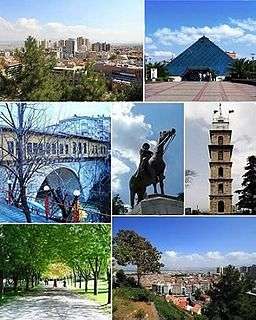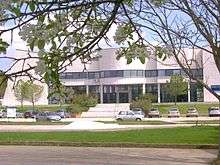Bursa
| Bursa | |
|---|---|
| City | |
| Bursa | |
|
Top left: City centre, Top right: Zafer Plaza AVM; Middle left: Irgandı Bridge, Middle: Statue of Atatürk, Middle right: Bursa Clock Tower; Bottom left: Bursa Botanical Park, Bottom right: City centre | |
 Bursa Location of Bursa | |
| Coordinates: 40°11′N 29°03′E / 40.183°N 29.050°ECoordinates: 40°11′N 29°03′E / 40.183°N 29.050°E | |
| Country |
|
| Region | Marmara |
| Province | Bursa |
| Settled | 5200 BC |
| Government | |
| • Governor | Izzettin Kucuk |
| • Mayor | Recep Altepe |
| Area | |
| • City | 1,036 km2 (400 sq mi) |
| Elevation | 100 m (300 ft) |
| Population (2015)[1][2] | |
| • City | 2,340,000 |
| • Density | 1,508.52/km2 (3,907.0/sq mi) |
| • Metro | 2,842,000 |
| Time zone | EET (UTC+2) |
| • Summer (DST) | EEST (UTC+3) |
| Postal code | 16000 |
| Area code(s) | (+90) 224 |
| Licence plate | 16 |
| Website | www.bursa.bel.tr |
| Official name | Bursa and Cumalıkızık: the Birth of the Ottoman Empire |
| Type | Cultural |
| Criteria | i, ii, iv, vi |
| Designated | 2014 (38th session) |
| Reference no. | 1452 |
| State Party |
|
| Region | Europe and North America |
Bursa is a large city in Turkey, located in northwestern Anatolia, within the Marmara Region. It is the fourth most populous city in Turkey and one of the most industrialized metropolitan centres in the country. The city is also the administrative centre of Bursa Province.
Bursa was the first major and second overall capital of the Ottoman State between 1335 and 1363. The city was referred to as Hüdavendigar (Ottoman Turkish: خداوندگار, meaning "God's gift") during the Ottoman period, while a more recent nickname is Yeşil Bursa (meaning "Green Bursa") in reference to the parks and gardens located across its urban fabric, as well as to the vast and richly varied forests of the surrounding region. The ski resort of Mount Uludağ towers over it. The mountain was called the Mysian Olympus by the Romans who lived there before. Bursa has rather orderly urban growth and borders a fertile plain. The mausoleums of the early Ottoman sultans are located in Bursa and the city's main landmarks include numerous edifices built throughout the Ottoman period. Bursa also has thermal baths and several museums, including a museum of archaeology.
The shadow play characters Karagöz and Hacivat are based on historic personalities who lived and died in Bursa. Bursa is also home to some of the most famous Turkish dishes such as İskender kebap, specially candied marron glacés, peaches and Turkish Delight. Bursa houses the Uludağ University, and its population can claim one of the highest overall levels of education in Turkey. The historic towns of İznik (Nicaea), Mudanya and Zeytinbağı are all situated in Bursa Province.
In 2015, Bursa had a population of 2,340,000, while Bursa Province had 2,842,000 inhabitants.[1][2]
History of Bursa
| Historical population | ||
|---|---|---|
| Year | Pop. | ±% |
| 1487 | 45,000 | — |
| 1927 | 61,451 | +36.6% |
| 1955 | 128,875 | +109.7% |
| 1980 | 487,604 | +278.4% |
| 2000 | 1,184,144 | +142.8% |
| 2014 | 1,800,278 | +52.0% |
| — | ||
The earliest known human settlement near Bursa's current location was at Ilıpınar Höyüğü around 5200 BC.[3] It was followed by the ancient Greek city of Cius, which Philip V of Macedon granted to Prusias I, the King of Bithynia, in 202 BC. Prusias rebuilt the city and renamed it Prusa (Ancient Greek: Προῦσα; sometimes rendered as Prussa). After 128 years of Bithynian rule, Nicomedes IV, the last King of Bithynia, bequeathed the entire kingdom to the Roman Empire in 74 BC. An early Roman Treasure was found in the vicinity of Bursa in the early 20th century. Composed of a woman's silver toilet articles, it is now in the British Museum.[4]
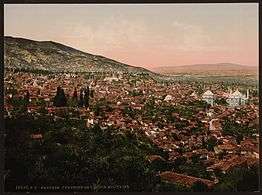

Bursa became the first major capital city of the early Ottoman Empire following its capture from the Byzantines in 1326. As a result, the city witnessed a considerable amount of urban growth throughout the 14th century. After conquering Edirne (Adrianople) in East Thrace, the Ottomans turned it into the new capital city in 1363, but Bursa retained its spiritual and commercial importance in the Ottoman Empire.[5] The Ottoman sultan Bayezid I built the Bayezid Külliyesi (Bayezid I theological complex) in Bursa between 1390 and 1395[6] and the Ulu Cami (Grand Mosque) between 1396 and 1400.[7] Bursa remained to be the most important administrative and commercial centre in the empire until Mehmed II conquered Constantinople in 1453. The population of Bursa was 45,000 in 1487.[8]
During the Ottoman period, Bursa continued to be the source of most royal silk products. Aside from the local silk production, the city imported raw silk from Iran, and occasionally from China, and was the main production centre for the kaftans, pillows, embroidery and other silk products for the Ottoman palaces until the 17th century.
Following the foundation of the Republic of Turkey in 1923, Bursa became one of the industrial centres of the country. The economic development of the city was followed by population growth and Bursa became the 4th most populous city in Turkey.
The city has traditionally been a pole of attraction, and was a major centre for refugees from various ethnic backgrounds who immigrated to Anatolia from the Balkans during the loss of the Ottoman territories in Europe between the late 19th and early 20th centuries. The most recent arrival of Balkan Turks took place in the 1940s until the 1990s, when the communist regime in Bulgaria expelled approximately 150,000 Bulgarian Turks to Turkey.[9] About one-third of these 150,000 Bulgarian Turkish refugees eventually settled in Bursa.
Geography
Bursa is settled on the northwestern slopes of Mount Uludağ in the southern Marmara Region. It is the capital city of Bursa Province bordered by the Sea of Marmara and Yalova to the north; Kocaeli and Sakarya to the northeast; Bilecik to the east; and Kütahya and Balıkesir to the south.
Climate
Bursa has a Mediterranean climate (Köppen climate classification: Csa) under the Köppen classification, and dry-hot summer temperate climate (Csa) Trewartha classification. The city has hot, dry summers that last from June until September. Winters are cold and damp, also containing the most rainfall. There can be snow on the ground which will last for a week or two.
| Climate data for Bursa (1950 - 2014) | |||||||||||||
|---|---|---|---|---|---|---|---|---|---|---|---|---|---|
| Month | Jan | Feb | Mar | Apr | May | Jun | Jul | Aug | Sep | Oct | Nov | Dec | Year |
| Record high °C (°F) | 23.8 (74.8) |
26.9 (80.4) |
32.0 (89.6) |
36.2 (97.2) |
36.5 (97.7) |
41.3 (106.3) |
43.8 (110.8) |
42.2 (108) |
38.9 (102) |
37.3 (99.1) |
31.0 (87.8) |
27.3 (81.1) |
43.8 (110.8) |
| Average high °C (°F) | 9.6 (49.3) |
10.9 (51.6) |
13.7 (56.7) |
18.8 (65.8) |
23.7 (74.7) |
28.4 (83.1) |
30.8 (87.4) |
30.9 (87.6) |
27.1 (80.8) |
21.7 (71.1) |
16.3 (61.3) |
11.7 (53.1) |
20.3 (68.54) |
| Daily mean °C (°F) | 5.4 (41.7) |
6.3 (43.3) |
8.4 (47.1) |
12.8 (55) |
17.5 (63.5) |
22.1 (71.8) |
24.6 (76.3) |
24.2 (75.6) |
20.1 (68.2) |
15.2 (59.4) |
10.7 (51.3) |
7.4 (45.3) |
14.56 (58.21) |
| Average low °C (°F) | 1.7 (35.1) |
2.2 (36) |
3.6 (38.5) |
7.2 (45) |
11.2 (52.2) |
14.9 (58.8) |
17.1 (62.8) |
17.1 (62.8) |
13.5 (56.3) |
9.9 (49.8) |
6.0 (42.8) |
3.6 (38.5) |
9 (48.22) |
| Record low °C (°F) | −19.2 (−2.6) |
−16.8 (1.8) |
−10.5 (13.1) |
−3.1 (26.4) |
0.9 (33.6) |
4.0 (39.2) |
9.0 (48.2) |
8.6 (47.5) |
4.4 (39.9) |
−1.0 (30.2) |
−5.4 (22.3) |
−16.3 (2.7) |
−19.2 (−2.6) |
| Average precipitation mm (inches) | 87.1 (3.429) |
74.5 (2.933) |
69.8 (2.748) |
63.2 (2.488) |
44.7 (1.76) |
33.8 (1.331) |
15.5 (0.61) |
15.9 (0.626) |
39.1 (1.539) |
68.2 (2.685) |
79.0 (3.11) |
105.0 (4.134) |
695.8 (27.393) |
| Average precipitation days | 14.8 | 13.1 | 12.8 | 11.4 | 8.5 | 5.9 | 3.1 | 3.0 | 5.2 | 9.2 | 11.3 | 14.2 | 112.5 |
| Mean monthly sunshine hours | 111.6 | 90.4 | 127.1 | 162.0 | 232.5 | 285.0 | 325.5 | 313.1 | 228.0 | 167.4 | 123.0 | 111.6 | 2,277.2 |
| Percent possible sunshine | 37.4 | 30.1 | 34.4 | 40.7 | 52.0 | 63.3 | 71.3 | 73.5 | 61.0 | 48.4 | 41.2 | 38.6 | 49.33 |
| Source: Turkish State Meteorological Service[10] | |||||||||||||
Economy
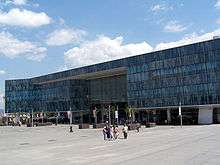
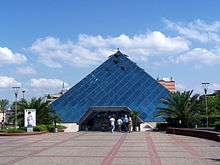
Bursa is the centre of the Turkish automotive industry.[11][12] Factories of motor vehicle producers like Fiat, Renault and Karsan, as well as automotive parts producers like Bosch, Mako, Valeo, Johnson Controls, Delphi have been active in the city for decades. The textile and food industries are equally strong, with Coca-Cola, Pepsi Cola and other beverage brands, as well as fresh and canned food industries being present in the city's organized industrial zones.
The top 10 industry corporations in the Bursa province are as follows:[13]
- Oyak Renault
- Tofaş Fiat
- Bosch
- Borçelik
- Sütaş Dairy Products
- Bursa Eczacılar Kooperatifi
- Türk Prysmian Kablo
- Özdilek
- Asil Çelik
- Componenta Döktaş
Apart from its large automotive industry, Bursa also produces a substantial amount of dairy products (by Sütaş'),[14] processed food (by Tat),[15] and beverages (by Uludağ).[16]
Traditionally, Bursa was famous for being the largest centre of silk trade in the Byzantine and later the Ottoman empires, during the period of the lucrative Silk Road. The city is still a major centre for textiles in Turkey and is home to the Bursa International Textiles and Trade Centre (Bursa Uluslararası Tekstil ve Ticaret Merkezi, or BUTTIM). Bursa was also known for its fertile soil and agricultural activities, which have decreased in the recent decades due to the heavy industrialization of the city.
Bursa is a major centre for tourism. One of the most popular skiing resorts of Turkey is located at Mount Uludağ, just next to the city proper. Bursa's thermal baths have been used for therapeutical purposes since Roman times. Apart from the baths that are operated by hotels, Uludağ University has a physical therapy centre which also makes use of thermal water.
Transportation
Bursa has a metro (Bursaray), trams[17] and bus system for inner-city public transport, while taxi cabs are also available. Bursa's Yenişehir Airport is 20 mi (32 km) away from the city centre. The citizens of Bursa also prefer Istanbul's airports such as Atatürk International Airport and Sabiha Gökçen International Airport for flights to foreign countries, due to Istanbul's proximity to Bursa. There are numerous daily bus and ferry services between the two cities.
The 8.8 km (5.5 mi) long Bursa Uludağ Gondola (Turkish: Teleferik) connects Bursa with the ski resort areas 1,870 m (6,140 ft) high on the mountain Uludağ.[18]
The only railway station in Bursa is the Harmancık station on the Balıkesir-Kütahya railway, which was opened in 1930.
Education
Bursa has two public universities and one private university. Uludağ University, founded in 1975, is the oldest institution of higher education in the city. Founded first as the Bursa University then renamed Uludağ University in 1982, the university has a student body of 47,000, one of the largest in Turkey. Bursa Technical University[19] is the second public university of Bursa and was established in 2010, beginning education in the 2011–2012 academic year.
The first private university of Bursa was the Bursa Orhangazi University,[20] which started education in the 2012–2013 academic year. Istanbul Commerce University has opened graduate programs in the city in 2013.[21] This university has been completely shut downed by Turkish Government after the failed coup attempt in 15 July 2016.
Sports
The city has one professional football club, Bursaspor, which competes in the Turkish Super League, the top-tier of Turkish football. As of December 21, the team plays their home games at The Timsah Arena stadium (literally meaning Crocodile Arena), which has a sitting capacity of 45,000. Bursaspor has won its first league title in the 2009–10 Turkish Super League season, becoming the second Anatolian club to ever win the league title after Trabzonspor. Today Bursaspor is considered one of the five biggest football clubs in Turkey along with Galatasaray SK, Fenerbahçe, Beşiktaş, and Trabzonspor.
The city has a professional basketball team in the Turkish Basketball League, Tofaş S.K., which was among the most successful teams.
Main sights
Ulu Cami (Grand Mosque)
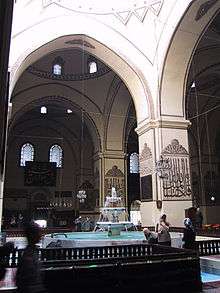
Ulu Cami is the largest mosque in Bursa and a landmark of early Ottoman architecture, which carried many elements from the Seljuk architecture. Ordered by Sultan Bayezid I, the mosque was designed and built by architect Ali Neccar in 1396–1400. It is a large and rectangular building, with a total of twenty domes that are arranged in four rows of five, and are supported by 12 columns. Supposedly the twenty domes were built instead of the twenty separate mosques which Sultan Bayezid I had promised for winning the Battle of Nicopolis in 1396. The mosque has two minarets.
Inside the mosque there are 192 monumental wall inscriptions written by the famous calligraphers of that period. There is also a fountain (şadırvan) where worshipers can perform ritual ablutions before prayer; the dome over the şadırvan is capped by a skylight which creates a soft, serene light below; thus playing an important role in the illumination of the large building.
The horizontally spacious and dimly lit interior is designed to feel peaceful and contemplative. The subdivisions of space formed by multiple domes and pillars create a sense of privacy and even intimacy. This atmosphere contrasts with the later Ottoman mosques (see for example the works of Suleiman the Magnificent's chief architect Mimar Sinan.) The mosques that were built after the conquest of Constantinople (Istanbul) by the Ottoman Turks in 1453, and influenced by the design of the 6th century Byzantine basilica of Hagia Sophia, had increasingly elevated and large central domes, which create a vertical emphasis that is intended to be more overwhelming; in order to convey the divine power of Allah, the majesty of the Ottoman Sultan, and the governmental authority of the Ottoman State.
Places of interest
A brief list of places of interest in and around Bursa is presented below. For a longer list, see places of interest in Bursa.
Mosques and külliye complexes
- Bursa Grand Mosque and külliye
- Yeşil Mosque and külliye
- Bayezid I Mosque and külliye
- Muradiye Mosque and külliye
- Emir Sultan Mosque and külliye
- Orhan Gazi Mosque and külliye
- Hüdavendigar Mosque and külliye
- Koca Sinan Paşa Mosque and külliye
- İshak Paşa Mosque and külliye
- Karacabey Grand Mosque
- Karabaş-i Veli Cultural Centre
Bazaars and caravanserais
- Yıldırım Bazaar
- Koza Han
- Pirinç Han
Other historic monuments
- Bursa Castle
- Irgandı Bridge
- Inkaya Sycamore, very big and impressive 600-year-old tree (Platanus Orientalis)
Museums
- Bursa Archaeological Museum
- Bursa City Museum
- Bursa Atatürk Museum
- Bursa Turkish Architecture Museum
- Bursa Islamic Works Museum
- Tofaş Museum of Cars and Anatolian Carriages
- Armistice of Mudanya Museum
- İznik Museum
Parks and gardens
- Uludağ National Park
- Bursa Zoo and Botanical Garden
Hot springs and thermal baths
- Keramet hot spring
- Çekirge hot spring
- Armutlu hot spring
- Oylat hot spring
- Gemlik hot spring
- Çelik Palas thermal bath
Beaches
- Armutlu beach
- Kumla beach
- Kurşunlu beach
- Orhangazi beach
- Mudanya beach
Volunteer Organizations
- Gönüllü Hareketi (Volunteer Movement)
Images from Bursa
 Statue of Atatürk and the Governorate of Bursa
Statue of Atatürk and the Governorate of Bursa_2.jpg)
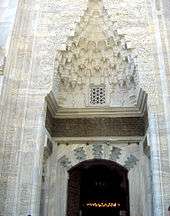 Entrance gate of the Yeşil Cami (Green Mosque)
Entrance gate of the Yeşil Cami (Green Mosque) Bursa Castle
Bursa Castle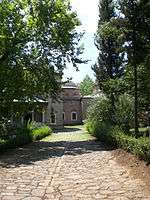 Muradiye Mosque and Külliye in Bursa
Muradiye Mosque and Külliye in Bursa Governorate of Bursa
Governorate of Bursa Ottoman era traditional houses in the Mudanya district of Bursa Province
Ottoman era traditional houses in the Mudanya district of Bursa Province Port of Mudanya
Port of Mudanya- Mt. Uludağ is a popular winter sport destination
- Bursa aerial tramway
 Irgandı Bridge (1442)
Irgandı Bridge (1442)- Atatürk Museum
 Şehreküstü Mosque
Şehreküstü Mosque Orhan Gazi Mosque
Orhan Gazi Mosque
Twin towns—Sister cities
 Darmstadt, Germany, since 1971[22][23]
Darmstadt, Germany, since 1971[22][23] Sarajevo, Bosnia and Herzegovina, since 1972[22]
Sarajevo, Bosnia and Herzegovina, since 1972[22] Multan, Pakistan, since 1975[22]
Multan, Pakistan, since 1975[22] Oulu, Finland, since 1978[22][24]
Oulu, Finland, since 1978[22][24] Tiffin, Ohio, United States, since 1983[22]
Tiffin, Ohio, United States, since 1983[22] Kairouan, Tunisia, since 1987[22]
Kairouan, Tunisia, since 1987[22] Denizli, Turkey, since 1988[22]
Denizli, Turkey, since 1988[22]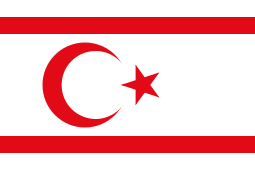 Lefkoşa, Northern Cyprus, since 1990[22]
Lefkoşa, Northern Cyprus, since 1990[22] Anshan, China, since 1991[22]
Anshan, China, since 1991[22] Bitola, Macedonia, since 1996[22]
Bitola, Macedonia, since 1996[22]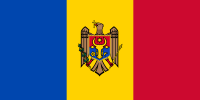 Ceadîr-Lunga, Moldova, since 1997[22]
Ceadîr-Lunga, Moldova, since 1997[22] Kyzylorda, Kazakhstan, since 1997[22]
Kyzylorda, Kazakhstan, since 1997[22] Muaskar, Algeria, since 1998[22]
Muaskar, Algeria, since 1998[22] Kulmbach, Germany, since 1998[22]
Kulmbach, Germany, since 1998[22] Pleven, Bulgaria, since 1998[22]
Pleven, Bulgaria, since 1998[22] Plovdiv, Bulgaria, since 1998[22]
Plovdiv, Bulgaria, since 1998[22] Tirana, Albania, since 1998[22]
Tirana, Albania, since 1998[22] Košice, Slovakia, since 2000[22][25]
Košice, Slovakia, since 2000[22][25] Vinnytsia, Ukraine, since 2004[22]
Vinnytsia, Ukraine, since 2004[22] Van, Turkey, since 2008[22]
Van, Turkey, since 2008[22] Rabat, Morocco, since 2010[22]
Rabat, Morocco, since 2010[22] Bakhchysarai, Russia, since 2010[22]
Bakhchysarai, Russia, since 2010[22] Gyeongsangbuk-do, South Korea, since 2011[22]
Gyeongsangbuk-do, South Korea, since 2011[22] Öskemen, Kazakhstan, since 2011[22]
Öskemen, Kazakhstan, since 2011[22]
See also
References
- 1 2 "Turkey: Major cities and provinces". citypopulation.de. Retrieved 2015-02-08.
- 1 2
- ↑ Roodenberg, J. J. (1995). The Ilıpınar Excavations I. the University of Michigan: Nederlands Historisch-Archaeologisch Institut in het Nabije Oosten te Istanbul. ISBN 9062580734.
- ↑ "British Museum - Collection search: You searched for Bursa, tomb". British Museum. Retrieved 25 May 2015.
- ↑ "In 1363 the Ottoman capital moved from Bursa to Edirne, although Bursa retained its spiritual and economic importance." Ottoman Capital Bursa. Official website of Ministry of Culture and Tourism of the Republic of Turkey. Retrieved 19 December 2014.
- ↑ "Bayezid I Complex". ArchNet. Archived from the original on 2011-05-25. Retrieved 2009-06-28.
- ↑ "Great Mosque of Bursa". ArchNet. Retrieved 2009-06-28.
- ↑ The city in the Islamic world, Volume 1, ed. Salma Khadra Jayyusi, Renata Holod, Attilio Petruccioli, André Raymond, page 362.
- ↑ Eminov, Ali, Turks and Other Muslim Minorities in Bulgaria, New York, Routledge, 1997, Hoepken, W., "Modernnisierung und Nationalismus: Sizialgeschichtliche Aspeckte der Bulgarischen Minder hertenpolitik gegennüber den Türken", Schönfeld, R., ed, Nationalitätenprobleme in Südosteuropa, Munich, Oldenbourg, 1997, p. 255-303, Erdinç, Didar, "Bulgaristan'daki Değişim Sürecinde Türk Azınlığın Ekonomik Durumu", Türkler, Ankara, 2002, s.394–400.
- ↑ "Meteoroloji" (in Turkish). Retrieved 8 January 2016.
- ↑ "Turkey's automotive industry going nonstop". Today's Zaman. 2007-05-05. Retrieved 2009-06-28.
- ↑ "TAYSAD met its members from Bursa". TAYSAD. 2008-02-08. Retrieved 2009-06-28.
- ↑ "Bursa'nın İlk 250 Sanayi Kuruluşu" (PDF). BTSO. 2014.
- ↑ "Sütaş Süt Ürünleri A.Ş.". Sütaş Süt Ürünleri A.Ş. Retrieved 25 May 2015.
- ↑ "Tat". Retrieved 25 May 2015.
- ↑ Uludağ Beverages
- ↑ DVV Media UK. "Bursa circular tramway opens". Railway Gazette. Retrieved 25 May 2015.
- ↑ "GD8 Bursa I + II + III - References - Company - LEITNER ropeways". www.leitner-ropeways.com. Retrieved 2016-09-14.
- ↑ "Bursa Teknik Üniversitesi". Btu.edu.tr. Retrieved 2013-03-26.
- ↑ "Bursa Orhangazi Üniversitesi". Bou.edu.tr. Archived from the original on 2013-03-18. Retrieved 2013-03-26.
- ↑ "Istanbul Commerce University at Bursa" (in Turkish). Archived from the original on 2012-08-27.
- 1 2 3 4 5 6 7 8 9 10 11 12 13 14 15 16 17 18 19 20 21 22 23 24 25 "Kardeş Şehirler" (in Turkish). Bursa Büyükşehir Belediyesi Basın Koordinasyon Merkez. Retrieved 2015-10-11.
- ↑ "Städtepartnerschaften und Internationales". Büro für Städtepartnerschaften und internationale Beziehungen (in German). Retrieved 2013-07-26.
- ↑ "Ystävyyskaupungit (Twin Cities)". Oulun kaupunki (City of Oulu) (in Finnish). Retrieved 2013-07-27.
- ↑ "Twin cities of the City of Kosice". Magistrát mesta Košice, Tr. Retrieved 2013-07-27.
External links
| Wikimedia Commons has media related to Bursa. |
| Wikivoyage has a travel guide for Bursa. |
- Bursa Uludag Ski Resort
- (Turkish) Bursa İlçe İsimleri ve Haritası
- Bursa Metropolitan Municipality
- (Turkish) Bursa Oto Kiralama
- Bursa Governorship
- Bursa Kultur AS. (Bursa Metropolitan Municipality)
- Tourism Guide of Bursa
